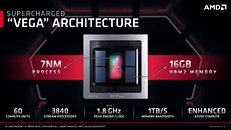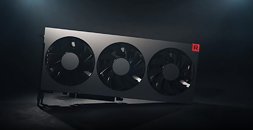Thursday, January 10th 2019

NVIDIA CEO Jensen Huang on Radeon VII: "Underwhelming (...) the Performance is Lousy"; "Freesync Doesn't Work"
PC World managed to get a hold of NVIDIA CEO Jensen Huang, picking his thoughts on AMD's recently announced Radeon VII. Skirting through the usual amicable, politically correct answers, Jensen made his thoughts clear on what the competition is offering to compete with NVIDIA's RTX 2000 series. The answer? Vega VII is an "underwhelming product", because "The performance is lousy and there's nothing new. [There's] no ray tracing, no AI. It's 7nm with HBM memory that barely keeps up with a 2080. And if we turn on DLSS we'll crush it. And if we turn on ray tracing we'll crush it." Not content on dissing the competition's product, Jensen Huang also quipped regarding AMD's presentation and product strategy, saying that "It's a weird launch, maybe they thought of it this morning."Of course, the real market penetration of the technologies Jensen Huang mentions is currently extremely low - only a handful of games support NVIDIA's forward-looking ray tracing technologies. That AMD chose to not significantly invest resources and die-space for what is essentially a stop-gap high-performance card to go against NVIDIA's RTX 2080 means its 7 nm 331 mm² GPU will compete against NVIDIA's 12 nm, 545 mm² die - if performance estimates are correct, of course.The next remarks came regarding AMD's FreeSync (essentially a name for VESA's Adaptive Sync), which NVIDIA finally decided to support on its GeForce graphics cards - something the company could have done outright, instead of deciding to go the proprietary, module-added, cost-increased route of G-Sync. While most see this as a sign that NVIDIA has seen a market slowdown for its G-Sync, added price-premium monitors and that they're just ceding to market demands, Huang sees it another way, saying that "We never competed. [FreeSync] was never proven to work. As you know, we invented the area of adaptive sync. The truth is most of the FreeSync monitors do not work. They do not even work with AMD's graphics cards." In the wake of these word from Jensen, it's hard to understand the overall silence from users that might have their FreeSync monitors not working.
Reportedly, NVIDIA only found 12 out of 400 FreeSync-supporting monitors to support their G-Sync technology automatically in the initial battery of tests, with most panels requiring a manual override to enable the technology. Huang promised that "We will test every single card against every single monitor against every single game and if it doesn't work, we will say it doesn't work. And if it does, we will let it work," adding a snarky punchline to this matter with an "We believe that you have to test it to promise that it works, and unsurprisingly most of them don't work." Fun times.
Source:
PC World
Reportedly, NVIDIA only found 12 out of 400 FreeSync-supporting monitors to support their G-Sync technology automatically in the initial battery of tests, with most panels requiring a manual override to enable the technology. Huang promised that "We will test every single card against every single monitor against every single game and if it doesn't work, we will say it doesn't work. And if it does, we will let it work," adding a snarky punchline to this matter with an "We believe that you have to test it to promise that it works, and unsurprisingly most of them don't work." Fun times.



270 Comments on NVIDIA CEO Jensen Huang on Radeon VII: "Underwhelming (...) the Performance is Lousy"; "Freesync Doesn't Work"
you can get tablets for nvidia addiction :) sounds like you have the same as poor mr Huang matey, times are a changing... you know im joking right.
... I'll see myself out.
lol how did i miss that, come back in i like you humor.
Beyond all that, the Radeon 7 does look good. So what, it's just a shrunk and higher clocked Vega. But it has twice the ROPS as previous, a huge increase that hamstrung the first Vega, and it has faster HBM, and twice as much as last time as well.
It's $700 because NVIDIA allowed them to price it at that; I can hardly blame AMD for taking advantage of NVIDIA's absofuckinglutely insane pricing.
The catch is that game developers have to write code to implement it, and the hardware has to be able to process it as well. Currently, these games are in the works to support it, at least to some degree or another:
www.pcper.com/reviews/Displays/AMD-FreeSync-First-Impressions-and-Technical-Discussion/Gaming-Experience-FreeSync-
They released a follow up article claiming the issue was fixed, but the ghosting was replaced by arguably more noticeable overshoot artifacts.
PCmonitors.info noted that the Samsung c24fg70 had overshoot artifacts with freesync at 100hz, and flickering on the desktop with freesync on.
pcmonitors.info/reviews/samsung-c24fg70/
Monitor reviews aren't as exciting as gpu or cpu reviews, and these things can easily go unnoticed by the community. Those overshoot and ghosting issues would be solved by dynamic overdrive, something nvidia requires for all gsync monitors.
He did say they're All broken.
And you Are hear trying to back his words, Have you seen this issue in the flesh??????
Everyone with some sense would expect the odd monitor or even line of monitor to have issues possibly but to say they're all broken ,well.
My Samsung works without artefacts etc but tbf it is a 45/75hz one so I can see it's not that model.
Kinda funny since that's exactly what I thought when reading the Turing reviews.
Tftcentral has it all in case you are curious. Not once has Freesync been considered related to ghosting or artifacting. The only gripe is limited ranges.
this is not about what AMD feels
memory bandwidth gives nothing to gaming performance on vega
it is not double the ROPs, they are still 64
but guess what ? I also suggest we waith for reviewsit's not really 7 nm, actual size is closer to intel's 10 nm.
I think I know whay he says freesync doesn't work "at all" on "all" monitors, I suspect he considers the concept of a monitor not running the same hertz range in freesync as it does without it.
which makes him right about that since it is a lie sold by specifications and makes people believe freesync is full range, this says something to many people here that say AMD is not as dirty as nvidea...
Sasqui Assetto CC have shit for graphics ray tracing is not going to do it any good
Also, your standard for "as dirty as" seems... uneven, to say the least. On the one hand, we have "created an open standard and didn't include strict quality requirements or enforce this as a condition for use of the brand name", while on the other we have (for example) "attempted to use their dominant market share to strong-arm production partners out of using their most famous/liked/respected/recognized brand names for products from their main competitor". Do those look equal to you?
yhe sure it can work in gaming, first vegas proved that :), im saying it like that becouse wrong chip for the wrong purpose, mybe better to augment polaris ?
you right AMD is better becouse they use the open standards approach, that's not the problem. for me the problem is that they are not doing it for good reasons, for us, it becouse they are doing it for themselfs...
thanks man that very elaborate response, you cleaned up a few things :)
I didn't know the freesync problems are becouse of the monitors not AMD or the freesync system itself
everyone are liers today about the nm eh ?
There is nothing stopping monitor companies from making sure their freesync monitors have finer control, but only one freesync monitor has implemented this, the nixeus edg27 (they call it adaptive antighosting).
So you could do the experiment, find a gsync and freesync ips monitor that uses the same panel, and you'll see that the gsync monitor will end up with better response times with a variable refresh rate, due to a better overdrive system, which was mandated by nvidia.